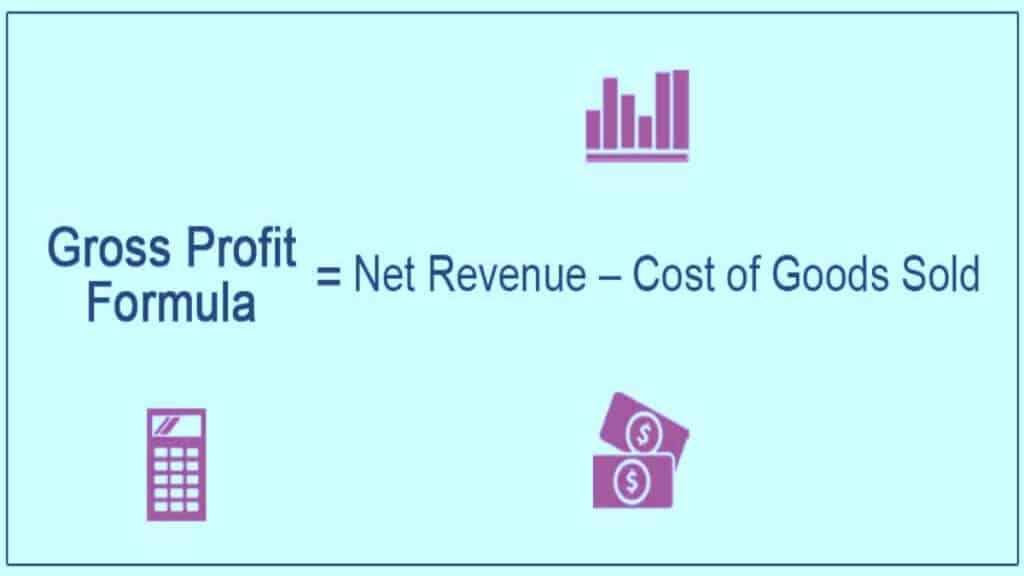In this article, we will talk about gross profit and also net profit in terms of the difference between them and also distinction. We will briefly explain the main addresses and branches that you are looking for. You should follow up and understand more from this article.
Table of Contents
Gross Profit :- What Is It ?
Gross profit is the amount of money a business makes after deducting costs for producing, distributing, and selling its goods or services. A company’s income statement will show gross profit, which is derived by deducting cost of goods sold (COGS) from revenue (sales). The income statement of a business will contain these numbers. Sales profit or gross income are other names for gross profit.
Calculation of Gross Profit

Net sales minus COGS = gross profit.
where :-
Net sales are the same as revenue, or the entire sum of money made from sales during the time period. Because it can include discounts and deductions from returned goods, it is sometimes known as net sales. Because it appears at the top of the income statement, revenue is frequently referred to as the top line. Net income, sometimes known as the bottom line, is calculated by deducting costs from revenue.
cost of goods sold equals cogs. the expenses directly related to creating goods. includes both direct labour costs and any material costs incurred during the manufacture or production of a company’s goods.
Gross profit :- What It Can Tell You
Gross profit measures how well a business uses its labour force and resources to produce goods and services. The metric primarily examines variable costs, or expenses that change depending on the volume of output, like :-
Materials
assuming direct labour is hourly or similarly reliant on production levels
pay bonuses to salespeople
Purchases made by customers using credit cards
Possibly using usage-based depreciation, equipment
for the production site, utilities
Shipping
According to the general definition, fixed costs (i.e. expenses that must be covered regardless of the amount of output) are not included in gross profit. Rent, advertising, insurance, salary for those not directly involved in the production, and office supplies are some examples of fixed costs.
However, it should be emphasised that under absorption costing, which is necessary for external reporting in accordance with generally accepted accounting principles (GAAP), a portion of the fixed cost is assigned to each unit of production.
For instance, under absorption costing, each widget would have a cost of $3 if a factory produced 10,000 widgets in a particular period and the business paid $30,000 in rent for the facility.
Operating profit and gross profit are two different concepts. By deducting operational expenses from gross profit, operating profit is calculated.
Whether a corporation employs variable costing, which is good for internal reporting but not allowed for external reporting, or absorption costing, which is necessary for external reporting, will affect its gross profit.
In relation to gross profit margin
The gross profit margin, a different statistic, can be computed using gross profit. This measure is helpful for tracking changes in a company’s production efficiency. Because gross earnings might climb while gross margins shrink, a dangerous pattern that could get a company into trouble, comparing gross profits alone from year to year or quarter to quarter can be misleading.
Although they seem similar and are occasionally used synonymously, gross profit and gross profit margin are not the same thing. The difference between gross profit and gross profit margin is given as a percentage. The following is the gross profit margin formula :-
Comparing gross profit to net income
Net profit, often known as net income, is distinct from gross profit. These two assessments serve very distinct objectives even though they both serve as indicators of a company’s financial capacity to produce sales and profit.
Net revenue is subtracted from gross profit to arrive at net profit. Net income is then calculated by deducting the company’s remaining operating costs. Gross profit simply takes into account the costs associated with the specific products that were sold, whereas net income is the profit made by a business after all expenditures have been taken into account.
These two computations are distinct from one another and are used for quite different objectives when determining how well a business is doing. Gross profit can be used to assess how effectively a business is handling its manufacturing spoilage, labour expenses, raw material procurement, and costs associated with production. In order to assess if a company’s enterprise-wide operations are profitable after accounting for administrative expenses, rent, insurance, and taxes, net income is helpful.
Because it appears at the bottom of an income statement, net income is frequently referred to as “the bottom line”. On an income statement, on the other hand, gross profit is frequently the third line from the top, below net revenue and cost of goods sold.
The Benefits of Gross Profit
There are a few reasons why a business would want to examine gross profit rather than net profit. Gross profit separates the effectiveness of the good or service being sold. A corporation can strategically consider how its products are doing or use greater cost management tactics by removing the “noise” of administrative or running costs.
Additionally, compared to other components of a corporation, gross profit is typically easier to monitor. Take into account expenses like rent, insurance, utilities (for business operations), or supplies In the course of doing business, some of those expenses are unavoidable and mostly unpredictable in terms of the costs incurred.

Contrarily, gross profit is determined by net revenue (which is largely determined by the price a firm sets) and cost of goods sold (which is primarily determined by the inputs a company spends for its product). There is value in occasionally restricting management’s perspective to primarily what it can control because a corporation can strategically change more aspects of gross profit than it can net profit.
Limitations of Gross Profit
Financial data services’ standardised income statements may show slightly varying gross profits. These statements, which are only available for public corporations, easily list gross earnings as a distinct line item.
Investors examining the income of private enterprises should get familiar with the cost and expense elements on a non-standardized balance sheet that may or may not be taken into account when determining gross profit.
Gross profit is helpful on the surface, but a business will frequently need to look farther to determine why it is failing. Consider a scenario in which a business learns that its gross profit is 25% lower than that of a rival. While gross profit can be used to pinpoint a problem, the company now needs to look at every source of income and every cost of goods sold item to fully comprehend why its performance is subpar.
Additionally, gross profit can be misleading, particularly when taking into account the profitability of service sector businesses. Think of a law firm that doesn’t charge for its services. In this instance, the revenue and gross profit of the law firm are the same. The rent expenditure for the corporate office, however, is double the monthly rent. When analysing gross profit, keep in mind that “below the line” costs can obscure a company’s remarkable performance.
What Is Measured by Gross Profit ?
Gross profit, commonly referred to as gross income, is calculated by deducting a company’s cost of goods sold (COGS) from its sales. It is frequently used to assess how effectively a business is controlling labour and resources throughout production. Generally speaking, variable costs—which change in relation to industrial output—are taken into account when calculating gross profit. Among other things, these expenses could involve labour, freight, and materials.
What Is a Gross Profit Example ?
Take a look at the following quarterly income statement, where a company’s revenues are $100,000 and its cost of goods sold is $75,000. Importantly, your computation would exclude any selling, general, and administrative (SG&A) costs from the category of expenses. The $100,000 in revenues would be subtracted from $75,000 in cost of goods sold to arrive at a total of $25,000 in gross profit.
What Sets Gross Profit Apart from Net Profit ?
Investors can evaluate how much profit a firm makes from the manufacturing and selling of its products by looking at the income that is left over after production costs are deducted from revenue.
In contrast, net profit, also known as net income, is the remaining profit after deducting all costs and expenses from revenue. It aids in demonstrating a company’s overall profitability, which has an impact on how well a company’s management is performing.
How Is Gros Profit Calculated ?
The difference between net revenue and the cost of products sold is known as gross profit. Total revenue is the sum of all sales, including any discounts and returns from customers. The distribution of costs necessary to produce the commodity or service for sale is known as the cost of goods sold.
the conclusion
A corporation can assess how successfully it is running the product-specific part of its business by deducting its cost of goods sold from its net revenue. By calculating gross profit, businesses may assess if their prices are reasonable, whether raw materials are being used effectively, and whether their labour expenses are too high. Generally speaking, gross profit aids a business in evaluating its performance without accounting for administrative or operating expenses.
Compete without risk for $100,000 in virtual money.
Utilise our FREE Stock Simulator to put your trading abilities to the test. Trade your way to the top while competing against hundreds of other Investopedia traders! Before risking your personal money, place trades in a virtual environment. Practise your trading techniques so that you will have the necessary experience when it comes time to enter the real market. Try out our stock simulator right away.
How Do Net Income and Net Profit Differ ?
An income statement includes both net income and net profit as measures of a company’s financial health. Although the two names may appear to be extremely similar, financial experts view them as two separate notions. It would be in your best interest to understand what these phrases signify and what purpose each performs if you’re interested in a career in corporate finance.
In this post, we define net income and net profit, discuss how they compare to one another, explain how to calculate both measures, and give an illustration of each to help you.
Key conclusions :-
Line items on an income statement include both net income and net profit. Both express how much a company has made after deducting costs and expenses.
Net income is the sum that is still available to a company’s equity investors. It can be seen as the statement’s final line item.
The equity for shareholders is not taken into account in net profit. Net profit takes the role of net income as the bottom line on an income statement for businesses without shareholders.
How much is net income ?
The money left over for equity investors after a corporation deducts all costs and expenses is known as net income. The bottom line of an income statement, a document that summarises a company’s financial performance over a certain time period, contains this indicator.
The amount of money available to pay dividends to equity shareholders is what net income primarily represents. Net income is also known as net earnings in some organisations.
Related Article :- What Is the Difference Between Gross and Net Profit ?
Who defines net profit ?
The term “net profit” also denotes a company’s earnings after costs and expenses, although it does not include any shareholder equity. It is also included in an income statement. For companies without shareholders, net profit appears on the statement’s bottom line rather than net income.
Net income and net profit
Both net income and net profit show how much money a company has made after deducting costs and expenses, but they differ in the following ways :–

Calculation
Not every company pays dividends to its shareholders and is publicly traded. Since net income directly relates to the amount of money distributed to shareholders, those without equity stockholders do not calculate it. Instead, these companies simply factor in net profit.
Both net income and net profit may be computed by companies with equity shareholders. They achieve this by figuring out earnings before taxes, taking that number and figuring out net income, and then arriving at the net profit. While net income and net profit are related and both use the same data to calculate, net income involves an extra step.
Use
Once determined, net income and net profit serve various purposes. This number reflects the earnings per share for businesses that have shareholders and compute net income. On the other hand, all firms utilise net profit to show how profitable they were during a particular time period.
Many organisations compare their net income and net profit to prior quarters to determine how they are doing.
Comparing net income and profit
An income statement, a crucial financial record that almost every firm utilises to evaluate its profitability and expenses, is the finest tool for calculating net profit and net income. Some companies disclose their net income, net profit, and total expenses using single-step income statements.
Single-step statements don’t include individual line items and are short and to the point. They instead provide the sum for each group.
Other companies opt to utilise multi-step income statements, which have separate line items for every kind of cost and revenue. Multi-step statements are more beneficial for people who want a deeper grasp of an organization’s financials due to its comprehensive nature. Such a statement would include the following items :-
Sales revenue :- The total amount of money received from sales is referred to as sales revenue. The income statement now has a positive entry.
Cost of goods sold :- The cost of goods sold includes any costs incurred by the company when producing or delivering its items. It is taken out of the sales proceeds.
Gross profit :- The amount left over after deducting the cost of items sold from the sales revenue
Any overhead expenses that the company incurred during the time period represented on the income statement are included in administrative expenses. It’s taken out of the gross profit.
EBITDA stands for earnings before interest, tax, depreciation, and amortisation. The remaining amount is what remains after administrative costs have been deducted.
Are You Interested in Business Education ?
For exclusive access to video classes given by business gurus including Howard Schultz, Chris Voss, Robin Roberts, Sara Blakely, Daniel Pink, Bob Iger, Anna Wintour, and more, get a Master Class Annual Membership.
Are net profit and net income the same thing ?
The same single number, known as net income or net profit, denotes a particular kind of profit. They represent an income statement’s bottom line.
Why is net income referred to as The Bottom Line ?
Because it shows the total profit after all costs and expenses, both direct and indirect, have been taken into account, net profit is also known as the bottom line. It can be found near the base of an income statement.



